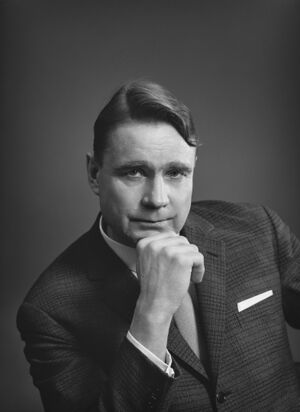Mauno Koivisto
(politician) | |||||||||||||||||||||
|---|---|---|---|---|---|---|---|---|---|---|---|---|---|---|---|---|---|---|---|---|---|
 | |||||||||||||||||||||
| Born | 25 November 1923 Turku, Finland | ||||||||||||||||||||
| Died | 12 May 2017 (Age 93) Helsinki, Finland | ||||||||||||||||||||
| Nationality | Finnish | ||||||||||||||||||||
| Alma mater | University of Turku | ||||||||||||||||||||
| Spouse | Tellervo Kankaanranta | ||||||||||||||||||||
| Party | Social Democratic Party of Finland | ||||||||||||||||||||
Finnish politician President of Finland from 1982 to 1994. Also the country's prime minister twice, from 1968 to 1970 and again from 1979 to 1982.
| |||||||||||||||||||||
Mauno Henrik Koivisto was a Finnish politician and ninth president of Finland from 1982 to 1994. He also was the country's prime minister twice, from 1968 to 1970 and again from 1979 to 1982.
Lauri Törni and stay behind
After attending primary school, Koivisto worked a number of jobs, and at the beginning of the Winter War in 1939 joined a field firefighting unit at the age of 16. During the Continuation War, Koivisto served in the Infantry Detachment Törni led by the Lauri Törni, an legendary infantry unit that penetrated deep behind enemy lines and soon enjoyed a reputation on both sides of the front for its combat effectiveness
This gives Koivisto a possible link to the stay behind network in Finland.
When Finland signed a ceasefire agreement with the Soviet Union in autumn 1944, Lauri Törni in January 1945 was recruited by the Pro-German resistance movement in Finland and left for saboteur training in Germany, with the intention of organizing resistance in case Finland was occupied by the Soviet Union.[1]
After the war Lauri Törni was sentenced to 6 years jail in Finland, but was pardoned in 1948. He ended up in the United States, where, in 1953, Törni was granted a residence permit through an Act of Congress[ that was shepherded by the law firm of "Wild Bill" Donovan, former head of the Office of Strategic Services.[2] Under the name Larry Thorne, he joined the Green Berets, a force that was involved in guerilla training for stay behind.
Several members of Infantry Detachment Törni were recruited by NATO intelligence agencies for covert reconnaissance of the Soviet Union in the 1950s[3].
Career
After the war, he earned a living as a carpenter and became active in politics, joining the Social Democratic Party.
In 1948, he found work at the port of Turku. In December 1948, he was appointed the manager of the Harbour Labour Office of Turku, a post he held until 1951. In 1949, communist-controlled trade unions attempted to topple Karl-August Fagerholm's Social Democratic minority government, and the Social Democratic leadership of the Finnish Confederation of Trade Unions (SAK) declared the port of Hanko an "open site", urging port workers who supported legality to go there. Koivisto went to Hanko to take charge of the harbour-master's office and recruit workers to break the strike, the government having banned strike action. The Communist newspapers branded Koivisto as their number one enemy due to his status as a major figure in the struggle for control of the trade unions.[4]
In addition to his political engagements and ongoing career, Koivisto continued with his education, passing his university entrance examination in 1949. In 1951, he became a primary school teacher.
In 1957, he started working for the Helsinki Workers' Savings Bank and was its general manager from 1959 to 1968.[5]
In 1966, he became finance minister in Rafael Paasio's government. Two years later he succeeded Passio as prime minister. In the same year, 1968, he was also appointed chairman of the board of the Bank of Finland. He continued as governor of the National Bank until he became president in 1982. As a result of this position, he also held several other positions in banking and industry during the same period.[6]
Presidency
Koivisto again became prime minister in 1979, becoming both the unofficial presidential candidate of the Social Democrats, and eventually also acting president when the 80-year-old Urho Kekkonen fell ill in the fall of 1981. One of his advantages as a presidential candidate was his role as an outsider, one who was not caught up in the political game. as president from 1982, it became his task to free domestic politics from the president's strong governance.
In foreign policy, he followed his predecessors' soft line towards the Soviet Union. Im the critical moments during which the Soviet Union was collapsing, and the Baltic countries, particularly Estonia, were declaring themselves independent, Koivisto covertly send money to Estonia to assist their independence movement and allowed its members to operate from Finland.[7][8] In public, Koivisto referred to the policy of neutrality and avoided publicly supporting the Baltic independence movement. Koivisto's Finland recognized the new Estonian government only after the major powers had done so.
The other major move was the renunciation of the 1948 Finno-Soviet Treaty in 1991, concurrently with the fall of Soviet Union. The treaty, the military article of which had shaped Finnish foreign policy for decades, was substituted with a new treaty without military obligations in the next year.
References
- ↑ Gill III, Henry A. (1998). Soldier Under Three Flags: The Exploits of Special Forces' Captain Larry A. Thorne. Ventura, CA: Pathfinder Publishing. ISBN 978-0934793650. OCLC 38468782. pp. 69, 72.
- ↑ https://www.gpo.gov/fdsys/pkg/STATUTE-67/pdf/STATUTE-67-PgA60.pdf
- ↑ https://yle.fi/aihe/artikkeli/2019/10/14/kylman-sodan-suomalaisagentit-kasikirjoitus
- ↑ https://www.blf.fi/artikel.php?id=633
- ↑ https://web.archive.org/web/20170807192103/https://www.suomenpankki.fi/en/bank-of-finland/organization/board/board-members-in-the-history-of-the-bank-of-finland/
- ↑ https://web.archive.org/web/20160327004037/http://tpk.fi/public/default.aspx?contentid=166716&nodeid=44829&contentlan=3&culture=sv-FI
- ↑ https://yle.fi/uutiset/osasto/news/ex-president_koivisto_secretly_funnelled_money_to_support_estonian_independence/9613509
- ↑ https://news.err.ee/596074/late-finnish-president-covertly-supported-estonian-independence